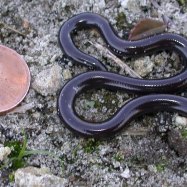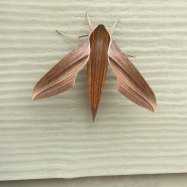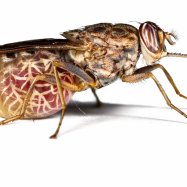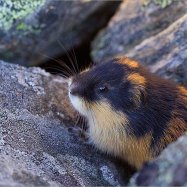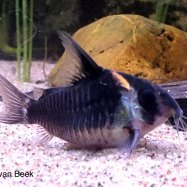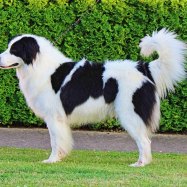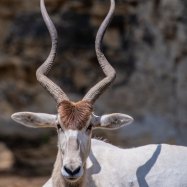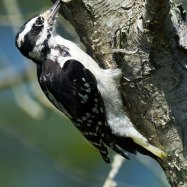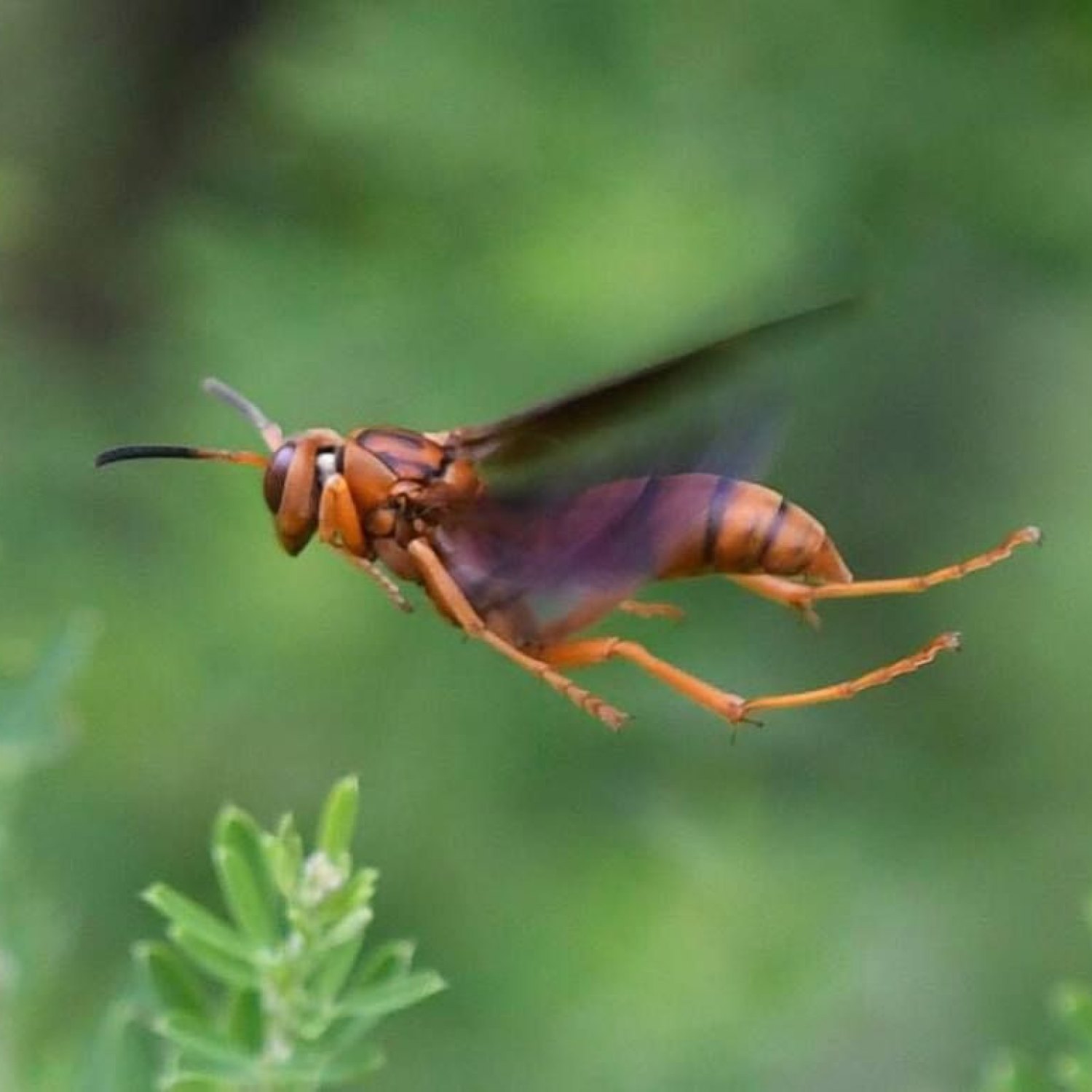
Red Paper Wasp
about 1 inch (2.5 cm)
Did you know that the Red Paper Wasp, found in eastern and central North America, is a slender and elongated wasp species? With a length of about 1 inch (2.5 cm), this member of the Vespidae family is known for its distinctive red color and paper-like nests. Keep an eye out for these fascinating insects in your backyard! #RedPaperWasp #NorthAmericanInsects #Vespidae
Animal Details Summary:
Common Name: Red Paper Wasp
Kingdom: Animalia
Habitat: Forests, woodlands, gardens, and urban areas
The Fascinating World of the Red Paper Wasp
The world is full of diverse and fascinating creatures, each with their unique characteristics and behaviors. One such animal that continues to captivate scientists and animal enthusiasts is the Red Paper Wasp, also known as Polistes carolina. This insect belongs to the Animalia kingdom and the Arthropoda phylum, making it an incredibly diverse and adaptable creature. From its striking red and black coloration to its omnivorous feeding habits, the Red Paper Wasp is truly a remarkable insect worth exploring Red Paper Wasp.Introduction to the Red Paper Wasp
The Red Paper Wasp, or Polistes carolina, is a type of wasp belonging to the Hymenoptera order and Vespidae family. These wasps can be found in forests, woodlands, gardens, and even urban areas, making them a common sight for many North American residents. They are endemic to North America, with the United States being their country of origin. More specifically, they can be found in eastern and central regions of North America.Physical Characteristics of the Red Paper Wasp
One of the most striking features of the Red Paper Wasp is its coloration. As the name suggests, these wasps are primarily red and black, with distinct patterns on their bodies. Their slender and elongated body shape gives them a distinctive appearance, making them easily identifiable in the wild. On average, adult Red Paper Wasps measure about 1 inch (2.5 cm) in length, making them relatively small compared to other wasp species Rubber Boa.These wasps have two pairs of wings, with the front pair being larger than the back. Their wings are transparent with dark veins running through them, giving them a unique and delicate appearance. The Red Paper Wasp also has six legs, each with sharp claws that help them grip onto surfaces and prey. As with most insects, the Red Paper Wasp has antennae on its head, which it uses to sense its surroundings and communicate with other wasps.
Behavior and Habitat of the Red Paper Wasp
As mentioned earlier, the Red Paper Wasp can be found in a wide range of habitats, ranging from forests to urban areas. They are adaptable creatures and can thrive in different environments as long as their basic needs are met. These wasps build their nests using paper-like material, which they create by chewing wood and mixing it with their saliva. The resulting papery substance is sturdy and serves as a protective barrier for their nest.Red Paper Wasps are social insects, and their colonies can consist of tens to hundreds of individuals. The colony is typically led by a single queen wasp, and the rest of the wasps take on specific roles such as foraging, nursing, and nest building. These wasps are active during the day, and their peak activity is usually during the warmer months of the year. However, they become increasingly sluggish during fall and eventually die off in the winter.
Feeding Habits of the Red Paper Wasp
Like many wasp species, the Red Paper Wasp is an omnivore, meaning it feeds on both plants and animals. Their diet primarily consists of nectar from flowers, pollen, and insects such as caterpillars and flies. However, during the larval stage, these wasps are unable to hunt for themselves, so they are fed by the adult wasps in the colony. This food is usually regurgitated and contains a mixture of nectar and insects, providing the larvae with all the nutrients they need to grow.Defensive Mechanisms of the Red Paper Wasp
While wasps are known for their aggressive nature, the Red Paper Wasp is relatively docile and will only attack when provoked. However, if they or their nest are threatened, these wasps can deliver a painful sting. Their stingers are located at the end of their abdomen, and they can sting multiple times, unlike bees that lose their stinger after one sting.Red Paper Wasps also have a unique defense mechanism where they can release an alarm pheromone to alert the rest of the colony if they feel threatened. This pheromone produces a strong odor that can attract other wasps to the area to help defend the nest. Interestingly, this pheromone has been found to have a calming effect on other wasps, and they will disperse once they realize there is no actual danger.
The Role of Red Paper Wasps in the Ecosystem
Just like any other living creature, the Red Paper Wasp plays a vital role in the ecosystem. As mentioned earlier, they feed on other insects, which helps control their populations and maintain a balance in the ecosystem. Additionally, these wasps are also pollinators, contributing to the reproduction of plants. They also serve as a food source for other animals such as birds, spiders, and even some mammals.The Importance of Protecting Red Paper Wasps
Despite their painful sting, Red Paper Wasps play a crucial role in the environment and must be protected. Unfortunately, their nest building habits have brought them into conflict with humans, and many people see them as a nuisance. This often leads to people destroying their nests or using insecticides to eradicate them, which can have harmful effects on the environment. It is essential to educate the public on the vital role these wasps play and the importance of coexisting with them.Final Thoughts
In conclusion, the Red Paper Wasp, also known as Polistes carolina, is a fascinating insect found in North America. Its striking coloration, social behavior, and unique defense mechanisms make it a popular subject of study and observation. As with any other living creature, it is vital to protect and appreciate these wasps for their role in the ecosystem. By learning more about them, we can better understand and coexist with these remarkable creatures.

Red Paper Wasp
Animal Details Red Paper Wasp - Scientific Name: Polistes carolina
- Category: Animals R
- Scientific Name: Polistes carolina
- Common Name: Red Paper Wasp
- Kingdom: Animalia
- Phylum: Arthropoda
- Class: Insecta
- Order: Hymenoptera
- Family: Vespidae
- Habitat: Forests, woodlands, gardens, and urban areas
- Feeding Method: Omnivorous
- Geographical Distribution: North America
- Country of Origin: United States
- Location: Eastern and central North America
- Animal Coloration: Red and black
- Body Shape: Slender and elongated
- Length: about 1 inch (2.5 cm)
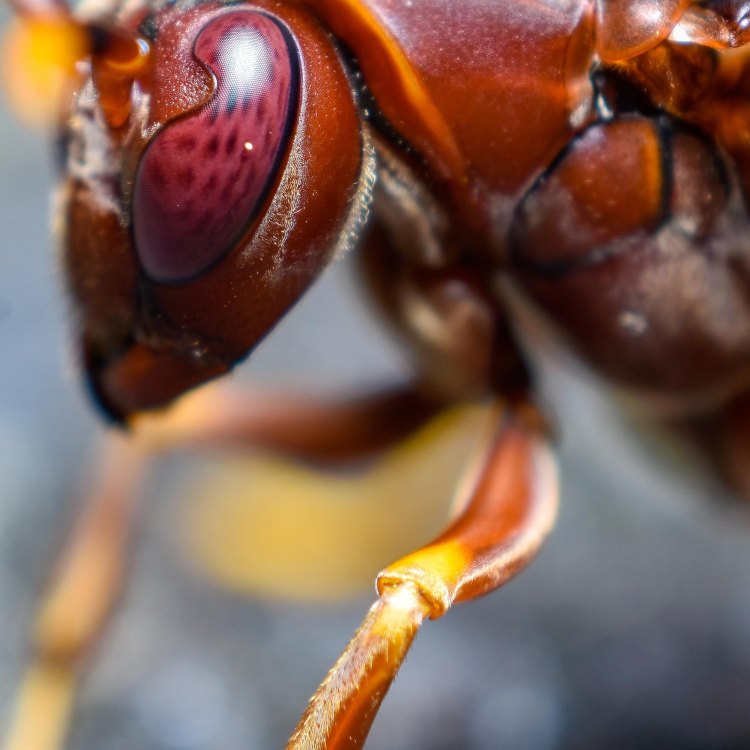
Red Paper Wasp
- Adult Size: Medium
- Average Lifespan: 1 year
- Reproduction: Sexual
- Reproductive Behavior: Queens mate with multiple males, and workers help with nest building
- Sound or Call: Buzzing
- Migration Pattern: Non-migratory
- Social Groups: Colonial
- Behavior: Aggressive if threatened
- Threats: Predators, parasites, and habitat loss
- Conservation Status: Not evaluated
- Impact on Ecosystem: Pollinators and natural pest controllers
- Human Use: None
- Distinctive Features: Red and black coloration, long legs, and slender body
- Interesting Facts: Red paper wasps build nests from chewed wood fibers
- Predator: Birds, spiders, and other insectivores
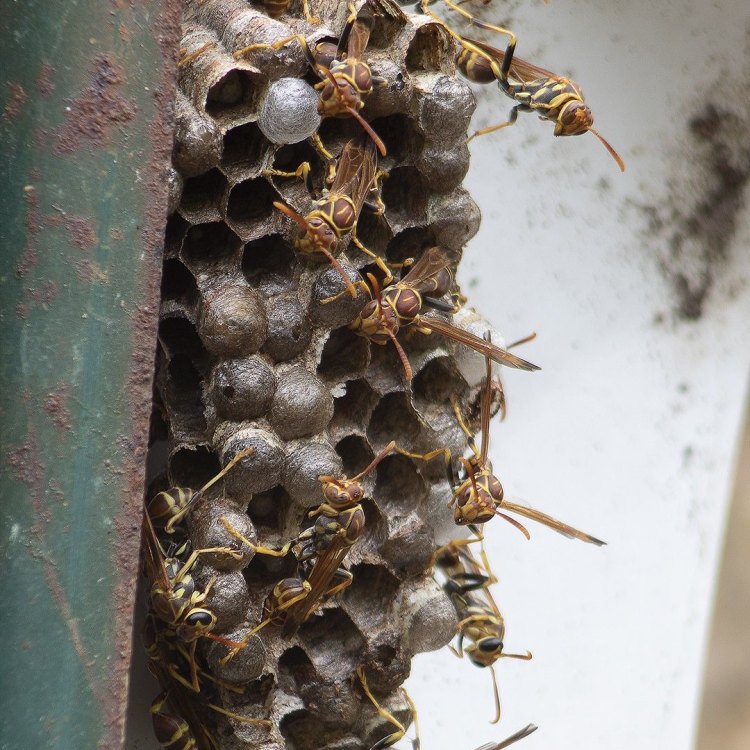
Polistes carolina
The Fascinating World of Red Paper Wasps: A Perfect Balance of Beauty and Function
The world is full of beautiful creatures, each with their unique features and purposes. Insects, in particular, often go unnoticed in our day-to-day lives, but they play a crucial role in maintaining the delicate balance of our ecosystems. One of these remarkable creatures is the red paper wasp (Polistes carolina), a small but mighty species found in various parts of North America. Despite its small size, the red paper wasp is a force to be reckoned with, as it possesses distinct features and behaviors that make it a valuable member of our natural world PeaceOfAnimals.Com.Size and Lifespan:
The red paper wasp has a medium-sized body, with an average length of 1 inch (2.5 cm). However, unlike other insects, their slender body and long legs give them an elongated appearance, making them stand out among their fellow wasps. These striking wasps have a vibrant red and black coloration, making them hard to miss in their natural habitat.
The average lifespan of the red paper wasp is one year, with the workers typically living for about 6-9 months. The queens, on the other hand, can survive for over a year, allowing them to build and maintain their colonies.
Reproduction and Reproductive Behavior:
The red paper wasp follows the traditional mode of sexual reproduction, with a queen mating with multiple males to produce offspring. Unlike other insects, where the queen is the sole provider for her young, red paper wasps have a more cooperative approach to nest building and rearing their young.
The red paper wasp colonies consist of a queen, who is the largest member of the colony, and her workers, who assist in building and defending the nest, foraging for food, and rearing the young Rottle. Although the queen is responsible for laying the eggs, the workers help her in nest construction, where they chew wood fibers to create the unique paper-like nests that give these wasps their name.
Sound or Call:
One of the first things you may notice when encountering a red paper wasp is the distinctive buzzing sound they emit. This sound is created by their wings beating rapidly as they fly around, and it serves as a form of communication. These wasps use different frequencies and patterns of buzzing to convey messages to other wasps, such as signaling danger or calling for help.
Migration Pattern and Social Groups:
Red paper wasps are not migratory insects, meaning they do not migrate to warmer regions during the colder months. Instead, they stay in their colonies, even during the winter season, by hibernating in protected areas, such as under tree bark or inside attics.
These wasps live in colonies with a complex social structure, where each member has a specific role to play. The queen is the head of the colony, and her main responsibility is reproduction. The workers, as mentioned earlier, assist in nest building and maintenance, as well as caring for the immature wasps. The male wasps, on the other hand, do not have a specific role in the colony and are only present for reproduction.
Behavior and Threats:
Red paper wasps are typically known to be aggressive, especially when their nest or young are threatened. They have a potent venom that they use to defend themselves and their colonies from predators. Although their sting can be painful and cause allergic reactions in some individuals, these wasps only sting when provoked.
The biggest threats to red paper wasps are predators, parasites, and loss of habitat. Birds, spiders, and other insectivores consider these wasps as a food source, while parasites, such as wasp flies, lay their eggs on the wasps, which then kill the host wasp once the larvae hatch. As with most insects, habitat loss also affects the survival of red paper wasps, as it limits their food sources and nesting sites.
Conservation Status and Impact on Ecosystem:
Despite their vital role in maintaining the balance of our ecosystems, the red paper wasp has not been evaluated for conservation status. However, their pollination and pest control activities have a significant impact on the environment and benefit humans in many ways.
As pollinators, red paper wasps play a crucial role in the reproduction of plants, making them vital for the growth and survival of our food sources. In addition, they are natural pest controllers, preying on insects such as caterpillars, flies, and spiders, helping to keep their populations in check.
Human Use and Distinctive Features:
Unlike other insects, the red paper wasp has not been used for any human purpose. They do not produce honey like honeybees or have any economic value, making them one of the few insects that humans do not use for any purpose.
Apart from their vibrant red and black coloration, one of the most distinctive features of red paper wasps is their unique nest-building behavior. As mentioned earlier, they build their nests by chewing wood fibers and mixing them with saliva to create a paper-like material that they then mold into their nests. These nests can have multiple cells and are often found attached to trees, eaves, or other protected areas.
Interesting Facts:
In addition to their unique nest-building behavior, red paper wasps have other fascinating facts that make them stand out in the world of insects. These wasps have exceptional memory and can recognize individual faces, both of their fellow wasps and humans. They also have advanced communication skills, using different scents, sounds, and movements to convey different messages.
Predators:
Like most insects, red paper wasps have several predators that pose a threat to their survival. Birds, such as bluebirds and grackles, are common predators of adult wasps. Spider wasps, tarantula hawks, and bald-faced hornets are also wasp species that prey on red paper wasps, while insectivorous animals such as bats and lizards also feed on their larvae.
In conclusion, the red paper wasp may seem like a small and insignificant creature, but they play a vital role in our ecosystem. Their distinctive features, unique behaviors, and important role in pollination and natural pest control make them a fascinating and valuable species that deserves our attention and protection. So next time you encounter a red paper wasp, take a moment to appreciate its beauty and significance in the delicate balance of our environment.
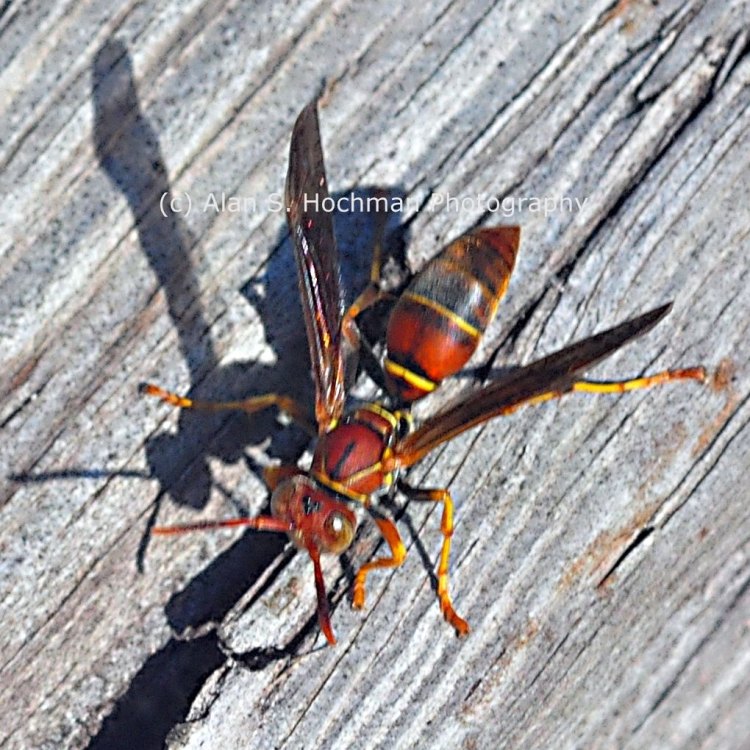
The Fascinating World of the Red Paper Wasp
Disclaimer: The content provided is for informational purposes only. We cannot guarantee the accuracy of the information on this page 100%. All information provided here may change without prior notice.




